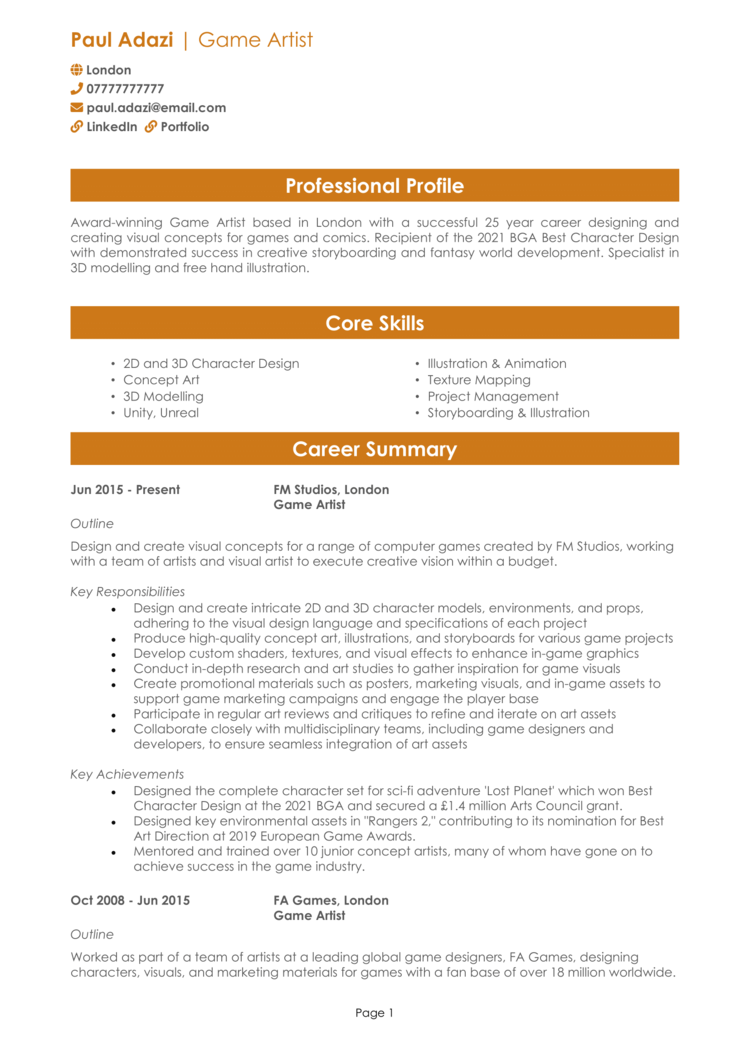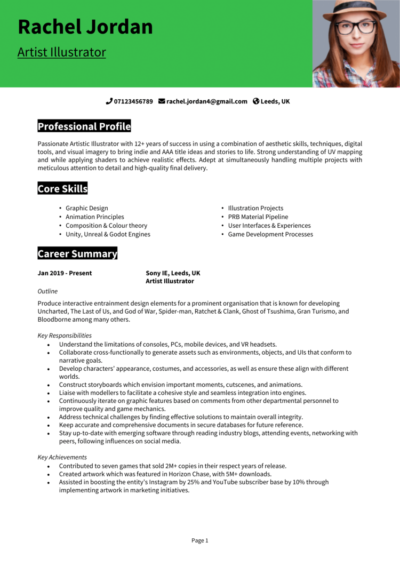You know how to turn ideas into stunning visuals, but before you can bring a brand’s vision to life, you need to make sure your CV paints the right picture.
If it looks like a rushed sketch instead of a polished final piece, recruiters might move on before they even click on your portfolio.
This writing guide includes 4 Illustrator CV examples and expert advice to help you craft an application that lands interviews.
Illustrator CV example

Artist CV example

Game Artist CV example

Fine Artist CV example

How to write your Illustrator CV
Learn how to create your own interview-winning Illustrator CV with this simple step-by-step guide.
An illustrator’s CV should be as polished and compelling as their artwork. This guide takes you through each step, from structuring and writing your CV to crafting content that highlights your artistic expertise, technical skills, and industry experience.
By the end, you’ll have a CV that showcases your talents as clearly as a well-composed illustration – without needing a revision request.
Structuring your Illustrator CV


Your CV structure should ensure that recruiters can find your key skills and experience at a glance – because let’s face it, nobody likes an overcrowded composition, especially in a CV.
Here’s the structure to follow:
- Name and personal details – Keep contact details at the top, with an optional photo of yourself, so clients and employers can reach you easily.
- Profile – Open with a strong summary that highlights your expertise in illustration, design, and visual storytelling.
- Core skills – Provide a quick snapshot of your most relevant artistic and technical skills, such as digital illustration, concept art, or branding.
- Work experience – Present your employment history in reverse chronological order, focusing on key projects and achievements.
- Education – List your degrees and certifications in order from most recent to oldest.
- Additional info – You could optionally include professional memberships, awards, exhibitions, or relevant hobbies and interests.
The best way to format your Illustrator CV


A recruiter’s first impression of your CV should be that it’s clean, well-organised, and easy to scan – just like good composition in an illustration. If your layout is chaotic and full of mistakes, it won’t reflect well on your attention to detail.
Ensure a quality CV format with these tips:
- Bullet points – Use them to keep your experience clear and readable.
- Divide sections – Structure your CV logically so recruiters can navigate it easily.
- Use a clear and readable font – Choose a professional, easy-to-read font instead of an overly decorative one.
- No more than 2 pages – Keep it concise while ensuring you cover all key qualifications and experience – any more length is unnecessary.
Illustrator CV profile


Your CV profile (or personal statement, if you’re low on experience) is your chance to make an impact right away. This brief introduction at the top of your CV should highlight your strongest skills and experience as an illustrator.
Tailor it to the job, ensuring you reflect what the employer is looking for in your CV profile. Think of it as the focal point of your CV – it needs to grab attention and set the tone.
Illustrator CV profile examples
Profile 1
Creative Illustrator with four years of experience producing digital and traditional artwork for books, branding, and editorial projects. Skilled in concept development, character design, and visual storytelling. Proficient in Adobe Illustrator, Photoshop, and Procreate, with a strong understanding of colour theory and composition. Passionate about creating compelling visuals that enhance narratives and engage audiences.
Profile 2
Detail-oriented Illustrator with three years of experience in commercial illustration, specialising in logo design, product packaging, and advertising campaigns. Adept at translating client briefs into unique, high-quality artwork that aligns with brand identities. Experienced in vector illustration, typography, and motion graphics. Skilled in collaborating with designers and marketing teams to create impactful visuals.
Profile 3
Experienced Illustrator with over six years of expertise in children’s book illustration, editorial artwork, and concept art for animation. Proficient in traditional and digital techniques, including watercolours, pen and ink, and digital painting. Skilled in working with publishers and authors to create visually engaging and age-appropriate illustrations. Passionate about storytelling through art and bringing creative visions to life.
What to include in your Illustrator CV profile
A strong profile should include the following:
- Where you’ve worked – Mention whether you’ve worked in publishing, advertising, gaming, animation, or as a freelancer.
- Your top qualifications – If you have a degree in Illustration, Fine Arts, or Graphic Design, highlight it here.
- Key illustration skills – Whether it’s character design, editorial illustration, or concept art, highlight your specialisms.
- Software expertise – Employers want illustrators who can work digitally, so mention your proficiency in tools like Photoshop, Illustrator, or Procreate.
- Unique artistic strengths – If you specialise in a particular style, medium, or technique, make sure to mention it.
How to present your core skills section properly


A core skills section is like a mood board – it gives recruiters a quick sense of what you bring to the table before they dive into the details.
This section should be tailored to the specific role, ensuring the skills listed match the job description.
Top skills for your Illustrator CV
- Digital Illustration – Creating detailed and high-quality artwork using software like Adobe Illustrator, Photoshop, or Procreate.
- Hand-Drawn Illustration – Mastering traditional techniques using pencils, ink, watercolour, or other physical media.
- Character Design – Developing unique and expressive characters for books, games, animations, or branding.
- Vector Artwork Creation – Designing scalable vector illustrations for logos, icons, and commercial use.
- Concept Art Development – Producing sketches and refined visuals to establish the look and feel of creative projects.
- Storyboarding – Crafting sequential illustrations to map out scenes for animations, films, or advertisements.
- Typography Integration – Incorporating custom lettering and artistic text into designs for visual impact.
- Colour Theory Application – Using colour schemes effectively to enhance mood, contrast, and composition.
- Print and Publishing Preparation – Formatting illustrations for books, posters, and other printed materials.
- Client Collaboration – Working closely with clients, art directors, or teams to refine concepts and deliver tailored illustrations.
Outlining your work experience


Your work experience section is where you prove you’re more than just talent – you’re a professional. A portfolio shows what you can create, but this section shows how you do it (and that you meet deadlines without ghosting clients halfway through a project).
List your roles in reverse chronological order, starting with the most recent. If you don’t have a long work history, include relevant freelance projects, internships, or personal commissions.
How to structure jobs

- Outline – Introduce the company, studio, or client you worked for and the nature of the work you did. Mention if it was for print, digital, animation, or branding.
- Responsibilities – Describe the tasks you handled, such as creating concept sketches, illustrating marketing materials, or designing book covers. Use action words like “designed”, “illustrated”, and “developed”.
- Achievements – Show measurable results where possible. Did your work increase audience engagement? Were your illustrations featured in a major campaign? Use numbers and outcomes where relevant.
Example jobs for Illustrator
Illustrator | StoryScape Publishing
Outline
Created engaging illustrations for children’s books, collaborating with authors and publishers to bring stories to life through vibrant and expressive artwork.
Responsibilities
- Designed and illustrated book covers and interior artwork tailored to target audiences.
- Worked closely with authors to ensure illustrations complemented story themes and narratives.
- Developed initial concept sketches and refined them into polished digital illustrations.
- Ensured artwork met publishing specifications, including print resolution and colour accuracy.
- Maintained consistent visual style throughout each project while meeting tight deadlines.
Achievements
- Illustrated six published children’s books, receiving positive reviews for artistic style.
- Improved production efficiency by 20 percent by streamlining the illustration process.
- Recognised by publishers for delivering high-quality illustrations ahead of schedule.
Artistic Illustrator | Creative Creators Agency
Outline
Designed custom illustrations for branding, marketing campaigns, and product packaging, ensuring visuals aligned with client brand identities and industry trends.
Responsibilities
- Created vector-based illustrations for logos, advertising materials, and merchandise.
- Developed engaging graphics for social media and promotional content.
- Collaborated with designers and marketing teams to ensure cohesive brand visuals.
- Worked with clients to refine concepts and adjust designs based on feedback.
- Managed multiple projects simultaneously while maintaining high creative standards.
Achievements
- Designed a successful product rebranding campaign that increased customer engagement by 25 percent.
- Helped a startup establish a strong visual identity through custom illustrations.
- Recognised by clients for creativity and the ability to adapt illustrations to brand needs.
Freelance Illustrator | Inkly Agency
Outline
Provided custom illustrations for a variety of clients, including book authors, small businesses, and content creators, creating unique visuals tailored to different artistic needs.
Responsibilities
- Developed custom illustrations for print and digital use, including posters, book covers, and marketing materials.
- Collaborated with clients to understand their vision and refine artwork based on feedback.
- Created character designs and concept art for independent animation and gaming projects.
- Designed infographics and editorial illustrations for blogs and online publications.
- Managed project timelines, ensuring consistent quality and timely delivery.
Achievements
- Completed over 50 successful freelance illustration projects with high client satisfaction.
- Increased social media following by 40 percent through self-promotion and showcasing work.
- Secured long-term collaboration with an independent publisher for multiple book projects.
Education section


Your education section should list any formal qualifications related to illustration, design, or fine arts. It should be brief, as artistic talent doesn’t come from a degree alone. This section should back up your skills, not overshadow them like a client’s so-called ‘small revisions’ request.
If you’re early in your career, highlight relevant coursework, workshops, or competitions that demonstrate your artistic development.
List your qualifications in reverse chronological order, starting with the most recent.
What are the best qualifications for Illustrators
- BA (Hons) Illustration – A widely recognised qualification that provides a strong foundation in traditional and digital illustration.
- MA in Illustration or Visual Communication – A postgraduate degree that helps illustrators refine their style and develop professional projects.
- Diploma in Graphic Design or Digital Illustration – Useful for those looking to work in branding, marketing, or digital media.
- Certification in Adobe Creative Suite (Illustrator, Photoshop, InDesign) – Demonstrates proficiency in industry-standard design software.
- Life Drawing and Anatomy Courses – Essential for illustrators focusing on character design, animation, or realistic depictions.





